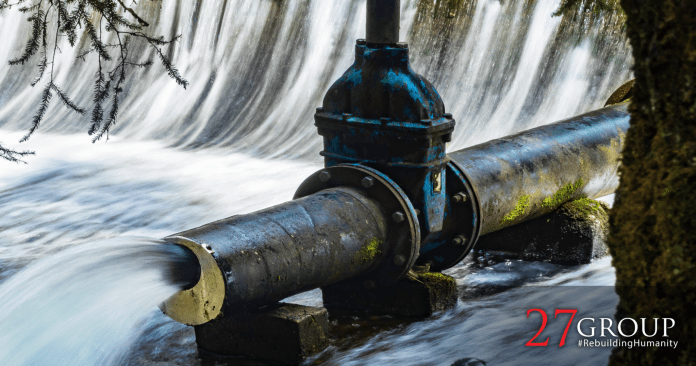The primary benefit from reducing NRW instances would obviously be that there would be better access to treated water and that that there would be a reduction in the associated financial losses that are incurred. In developing counties alone, about 8 billion cubic meters of water per year would become available if physical losses were reduced by half, which is enough to meet the needs of an additional 90 million people deprived of pipe water. This would in turn save about $1.6 billion per year in production and pumping costs for public utilities. Reducing commercial losses in developing countries by half would free up a further $1.3 billion in additional revenues.
Challenges in reducing NRW
Broadly speaking, the challenges inherent in reducing NRW levels are two-fold, with respect to the two different types of NRW, which are physical and commercial. With regards to physical NRW, the challenge of NRW reduction lies in the ability of private and public entities to detect the instances of water supply disruptions and carry out the appropriate repairs and maintenance works accordingly.
This can require a substantial amount of physical work and often calls for well planned, strategic, and consistent efforts for results to be noticeable and effective. With regards to commercial NRW reduction, this requires deliberate political will from the government as well as public institutions and authorities to exert pressure and take corrupt persons to task for the illegal tampering of water supplies.
In terms of the costs involved, the reduction of commercial NRW can be done with little financial expenditure and when implemented, can bring about immediate financial and real gains. Physical NRW reduction, on the other hand, often requires a substantial financial commitment on the part of the government and designated private contractors and must be done at large scale for the investment to show justifiable returns.
The private sector’s involvement in this process can and has been shown to bring about significant improvements in terms of NRW reductions, as private sectors can fill the gaps that utilities providers are unable to resolve. Inadequate incentives as well as a lack of expertise, technology, and the practical experience inherent in putting together large-scale projects and implementations, hinder the capacity of utilities providers to adequately implement effective reduction programs. Through long-term PPP arrangements, service contracts, subcontracting, or some combination of these business agreements, the private sector can bring an added level of competence and efficiency to NRW reduction efforts.
Private companies can improve NRW reduction programs by:
- Introducing effective existing and emerging technologies that improve visibility over water distribution systems and enable more strategic and effective responses
- Creating a more attractive, competitive, and fair incentive framework for project performance
- Developing versatile, creative solutions throughout the design and implementation processes of the program
- Making qualified human resources available for project works
- Allowing for greater flexibility of field work (such as with night crews)
- Attracting investment into NRW reduction activities, under acceptable and legitimate conditions
Solutions to NRW
In terms of resolving the issue of non-revenue water, the first step is to determine where exactly water loss is occurring within a water distribution network. This can be done by conducting an unvalidated water audit, in which desktop studies are carried to determine areas which are potential water loss zones, and which would likely require a more detailed follow up inspection. This is then followed by a validated water audit, in which water meters are sampled and tested, billing errors are resolved, and aerial mapping and field surveys are carried out to identify illegal connections.
Once this is done the utility company can then establish non-revenue water zones where water loss rates are the highest and directly track water loss and usage in these areas by installing additional meters. They can then perform component-based leakage modelling to pinpoint possible loss locations, allowing for easier discovery, repair, and replacement of leaking service connections, with consistent follow up monitoring and pressure management to avoid further leakages.
The use of technology is becoming increasingly relevant towards non-revenue water prevention, whereby computer-based systems that integrate software, sensors, communications, automations, and controls are being introduced to assist in the detection of leakages and the monitoring of water supply networks.
There has been a recent mushrooming of companies that are developing technology-based solutions to help address water loss issues in recent years. Some of the solutions that have been put forward include a digital pressure management system which enables real time dynamic pump scheduling, a system that compares household water usage among similar residents, as well as a smartphone application that provides fast, efficient, and accurate surveying and pinpointing of water leakages.
Such technologies promise to provide greater clarity and oversight over water supply flows and disruptions, allowing for the monitoring of and response to non-revenue water events to achieve greater agility, seamlessness, and effectiveness.
Indeed, this issue of Non-Revenue Water remains a challenge towards achieving greater socioeconomic growth and stability, especially so in developing counties. Globally, as populations continue to increase and as climate change puts further strain on naturally occurring resources, the imperative to ensure that our water network systems are robust and resilient is more pressing than ever.
Governments will need to take a hard line on addressing non-revenue water concerns, particularly with regards to commercial losses and the corrupt practices that are associated with it, while also spurring utilities companies as well as the private sector onwards towards conducting audits and engaging more actively in NRW maintenance, repair, and overall responsiveness.
Current and emerging technologies will certainly play a more central role in non-revenue water reduction as water networks gravitate towards digitalised grids and more connected automation solutions are introduced to improve the quality and efficiency of water management processes and enable quick and effective NRW response times
With deliberate, well planned, and well-structured collaborative programs between utilities providers, the private sector, and governments, NRW reductions can be achieved to allow for the effective and unimpeded flow of clean water within resilient distribution networks. Such efforts will go a long way towards throwing out the bathwater that is NRW, allowing us to strike a steady path towards greater integrity, efficiency and sustainability in our global water supply systems for both present and future generations to come.
27Group are strategic nation building consultants with a shared vision of rebuilding humanity.










